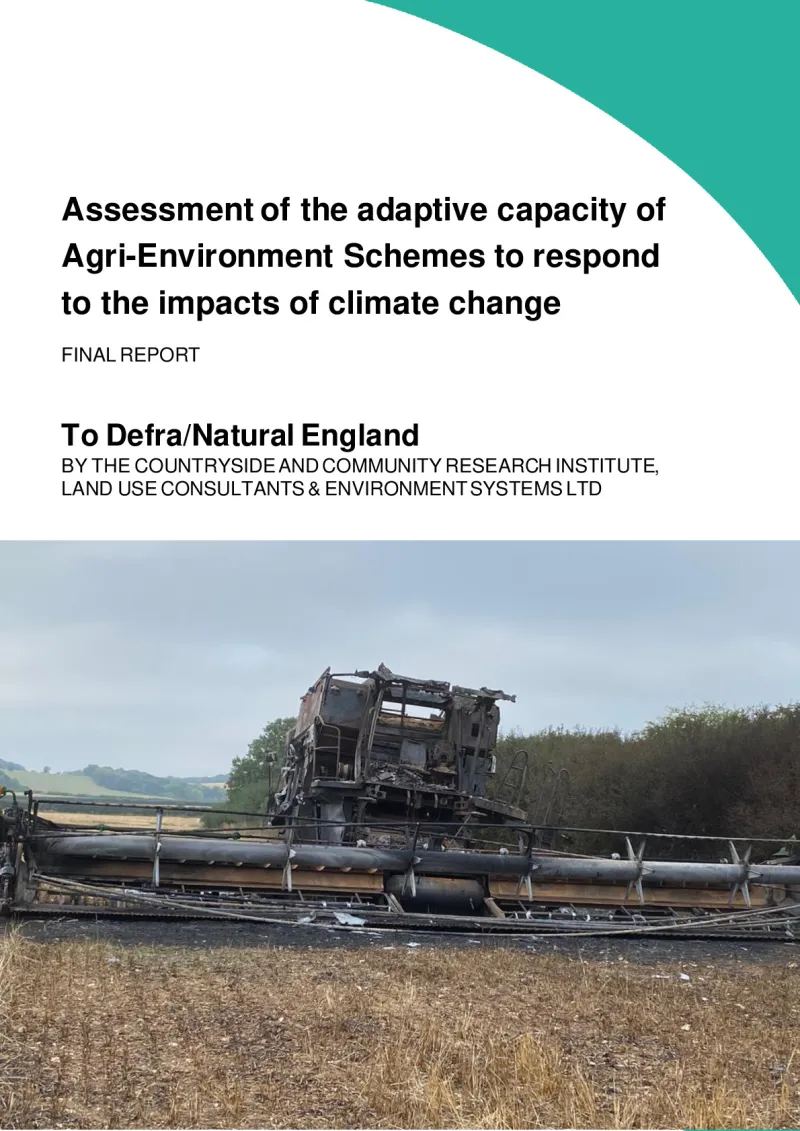Bewertung der Anpassungsfähigkeit von Agrarumweltprogrammen an die Auswirkungen des Klimawandels
In der Studie wird untersucht, ob sich der Klimawandel auf die Fähigkeit der Vertragsinhaber auswirkt, die Vorgaben und Erfolgsindikatoren der Agrarumweltregelung (AES) zu erfüllen, und ob die AES flexibel genug ist, um Veränderungen in der natürlichen Umwelt Rechnung zu tragen.
- Other
- 2014-2022
- Environmental impacts


Ziel dieses von DEFRA/Natural England in Auftrag gegebenen Berichts, der den Zeitraum 2018–2020 abdeckt, war es, zwei Fragen zu beantworten: 1) Gibt es Belege dafür, dass die Auswirkungen des Klimawandels die Fähigkeit der Vertragsinhaber beeinträchtigen, die AES-Vorgaben und Erfolgsindikatoren zu erfüllen? 2) Ist die Funktionsweise (sowohl die Gestaltung als auch die Umsetzung) der AES flexibel genug, um sicherzustellen, dass sie sich an Veränderungen der natürlichen Umwelt infolge des Klimawandels anpassen kann, ohne die gewünschten Umweltergebnisse der Programme zu beeinträchtigen?
Hinsichtlich des Klimawandels wurden zwei verschiedene Aspekte berücksichtigt. Erstens die allmählichen Auswirkungen des Klimawandels und zweitens die Herausforderungen aufgrund der Schwere und Häufigkeit extremer Wetterereignisse.
Die Methodik bestand aus einer Bewertung einer Reihe von AES-Optionen und den damit verbundenen Vorschriften, die Termine für erforderliche Maßnahmen festlegen und die sich auf bestimmte ökologische Ereignisse beziehen. Darüber hinaus wurde eine Online-Umfrage bei den Inhabern von Vereinbarungen in Cumbria, Somerset und West Anglia durchgeführt, um Erkenntnisse über die Auswirkungen extremer Wetterereignisse auf die Fähigkeit der Inhaber von Vereinbarungen, AES-Vereinbarungen zu erfüllen, und die damit verbundenen Umweltergebnisse zu sammeln. Abschließend wurden Telefoninterviews mit Vereinbarungsinhabern und Beratern aus den Untersuchungsgebieten und anderswo geführt, um detailliertere Informationen über die Auswirkungen extremer Wetterereignisse und ihre Erfahrungen mit der AES auf lokaler Ebene sowie Verbindungen zu Klimadaten und Trends zu sammeln.
Insgesamt ergab die Umfrage, dass mehr als 90 % der Befragten von extremen Witterungsbedingungen betroffen waren, und für etwas mehr als ein Drittel der Befragten war dies in den letzten fünf Jahren mindestens einmal „schwerwiegend“. Mehr als 70 % der Befragten berichteten von extremer Hitze, 65 % von extremer Nässe, 68 % von untypischen Witterungsbedingungen und -zeitpunkten (z. B. früher Frühling oder warmer Winter) und 57 % von Trockenheit, die die vier wichtigsten Faktoren darstellten.
Die Auswirkungen von trockenem und heißem Wetter sind offenbar landesweit verbreitet und betreffen alle drei Fallstudiengebiete, wohingegen nasses Wetter eher lokal begrenzt ist und eine Reihe von Auswirkungen hat, die schwerwiegend sein können. Das Auftreten extremer Witterungsbedingungen machte die Einhaltung der Umweltergebnisse der AES-Vereinbarungen schwieriger, da der Eindruck entstand, dass es an Flexibilität fehlte, um auf die Umstände im Umfeld des Vertragsinhabers zu reagieren. Diejenigen, die Erfahrungen mit den Verwaltungsverfahren im Zusammenhang mit der Anpassung einer AES-Vereinbarung gemacht haben, weisen darauf hin, dass dies nicht einfach ist und das Verfahren für Ausnahmeregelungen oder geringfügige vorübergehende Anpassungen (Minor Temporary Adjustment – MTA) komplex ist. Die Verfahren im Zusammenhang mit der Basisprämienregelung (Basic Payment Scheme, BPS) sind mit ähnlichen Herausforderungen verbunden wie die der AES und werden von Landwirten und Landverwaltern als komplex und abgelegen angesehen.
Darüber hinaus zeigen die Interviews mit den Vertragsinhabern und Beratern, dass sie sich der Veränderungen der Witterungsmuster und der Auswirkungen extremer Witterungsbedingungen sowohl auf ihre landwirtschaftlichen Betriebe als auch auf die AES-Vereinbarungen bewusst sind. Extreme Witterungsverhältnisse wirken sich auf die Wirksamkeit von Terminen für Arbeiten wie das Schneiden von Binsen und Gras für die Heuernte aus. In manchen Jahren sind die Termine zu spät, was darauf hindeutet, dass ein flexiblerer Ansatz für die Erfüllung der Umweltergebnisse vorteilhafter wäre. Trockenheit und Hitze sind Faktoren, die in ganz England weit verbreitet sind und spezifische Auswirkungen auf verschiedene landwirtschaftliche Systeme haben, wobei Überschwemmungen und extreme Nässeereignisse eher im Norden und Westen auftreten. Die Art des Bodens und seine Bewirtschaftung sind Schlüsselfaktoren für die Verringerung der Auswirkungen extremer Wetterverhältnisse. Eine bessere Bodenstruktur und ein hoher Anteil an organischer Substanz bedeuten, dass die Böden in Zeiten von Hitze und Trockenheit Feuchtigkeit speichern können, und eine höhere Bodenporosität trägt zur Verringerung des Oberflächenabflusses bei. Die Umsetzung einiger Optionen kann sich als schwierig erweisen, aber Peer-to-Peer-Learning, Wissensaustausch und die Unterstützung durch einen lokalen Berater helfen, diese Schwierigkeiten zu überwinden.
Das Auftreten extremer Witterungsbedingungen hat die Erfüllung der Umweltergebnisse der AES-Vereinbarungen erschwert, da die Flexibilität bei der Durchführung der Programme als unzureichend empfunden wird. Einige Landwirte beantragen mindestens eine Ausnahmeregelung pro Jahr, während andere keine Ausnahmeregelung beantragen, da das Verfahren zu lange dauert, um dem Antrag stattzugeben, und nicht lokal verwurzelt ist. Berater und Vertragsinhaber befürworten die Möglichkeit der lokalen Berater von Natural England, kleinere Änderungen der AES-Vereinbarungen auf lokaler Ebene zu genehmigen (z. B. frühere Schnitttermine). Das derzeitige System der Ausnahmeregelungen funktioniert recht gut bei größeren Änderungen der AES-Vereinbarung, z. B. bei der Änderung der Reihenfolge der Arbeiten und des Standorts. Während und unmittelbar nach Extremereignissen sind die Prioritäten für den Inhaber einer AES-Vereinbarung der landwirtschaftliche Betrieb (z. B. Viehbestand) und seine Infrastruktur (z. B. Gebäude). Extremereignisse profitieren davon, dass sie zentral nach vereinbarten Kriterien behandelt werden, die auf der Grundlage des derzeitigen Fonds zur Wiederherstellung landwirtschaftlicher Betriebe lokal umgesetzt werden.
Author(s)
Countryside and Community Research Institute